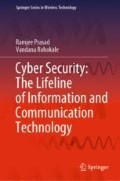Abstract
FedEx Corporation, a global courier system, Russian criminal investigation agency and a top mobile operator, Megaphone, United Kingdom healthcare centers, worldwide banking services have come under recent malware attack during massive WannaCry Ransomware attack wave (Associated Press, ABC News 2017). Nowadays our society is successfully going towards tech savvy mode. This is very positive step towards growth, but at the same time our infrastructure relies on technology as well as computers. A threat to the computing system has become a threat to the society. There are four key threats to consider like Spam, Bugs, Denials of service, malicious software, etc.
Access this chapter
Tax calculation will be finalised at checkout
Purchases are for personal use only
References
Aafer Y, Du W, Yin H (2013) DroidAPIMiner: mining API-level features for robust malware detection in android. In: Security and privacy in communication networks. Springer, pp 86–103
Arp D, Spreitzenbarth M, Hubner M, Gascon H, Rieck K (2014) Drebin: effective and explainable detection of android malware in your pocket. In: NDSS
Associated Press, ABC News (2017) The latest: FedEx confirms it hit by malware attack, 12 May 2017. http://abcnews.go.com/Technology/wireStory/latest-uks-health-service-hit-ransomware-attack-47372081
Cao Y et al (2013) Abstracting minimal security-relevant behaviors for malware analysis. J Comput Virol Hack Tech 9(4):193–204
Center for Internet Security (CIS) Blog (2019) Top 10 malware January 2019. https://www.cisecurity.org/blog/top-10-malware-january-2019/
Chouhan PK et al (2014) Network based malware detection within virtualized environments. In: Euro-Par 2014: parallel processing workshops. Springer International Publishing
Cobb S, Lee A (2014) Malware is called malicious for a reason: the risks of weaponizing code. In: 6th international conference on cyber conflict
Cucu P (2017) Rootkit—the (nearly) undetectable malware. Heimdal Security Blog. https://heimdalsecurity.com/blog/rootkit/
Enck W, Ongtang M, McDaniel P (2009) On lightweight mobile phone application certification. In: Proceedings of the 16th ACM conference on computer and communications security. ACM, pp 235–245
Felt AP, Chin E, Hanna S, Song D, Wagner D (2011) Android permissions demystified. In: Proceedings of the 18th ACM conference on computer and communications security. ACM, pp 627–638
Fisher R, Davis A (2018) BIOS boots what? Finding evil in boot code at scale. FIREEYE blog on threat research. https://www.fireeye.com/blog/threat-research/2018/08/bios-boots-what-finding-evil-in-boot-code-at-scale.html
Grace M, Zhou Y, Zhang Q, Zou S, Jiang X (2012) Risk ranker: scalable and accurate zero-day android malware detection. In: Proceedings of the 10th international conference on mobile systems, applications, and services. ACM, pp 281–294
Jadhav A, Vidyarthi D, Hemavathy M (2016) Evolution of evasive malwares: a survey. In: International conference on computational techniques in information and communication technologies (ICCTICT)
Kim CH, Kamundala KE, Kang S (2018) Efficiency-based comparison on malware detection techniques. In: International conference on platform technology and service (PlatCon)
Lakhotia A, Black P (2017) Mining malware secrets. In: 12th international conference on malicious and unwanted software (MALWARE)
Le TA, Chu TH, Nguyen QU, Nguyen XH (2014) Malware detection using genetic programming. In: 2014 seventh IEEE symposium on computational intelligence for security and defense applications (CISDA), Dec 2014, pp 1–6
Lindorfer M, Neugschwandtner M, Platzer C (2015) Marvin: efficient and comprehensive mobile app classification through static and dynamic analysis. In: 2015 IEEE 39th annual computer software and applications conference (COMPSAC), vol 2. IEEE, pp 422–433
Liţă CV, Cosovan D, Gavriluţ D (2017) Anti-emulation trends in modern packers: a survey on the evolution of anti-emulation techniques in UPA packers. J Comput Virol Hack Tech
Martin A, Menéndez HD, Camacho D (2016) MocDroid: multi-objective evolutionary classifier for android malware detection. In: SoftComputing, pp 1–11
Moser A, Kruegel C, Kirda E (2007) Limits of static analysis for malware detection. In: Twenty-third annual computer security applications conference. ACSAC, Dec 2007, pp 421–430
Ostaszewski M, Seredynski F, Bouvry P (2007) Coevolutionary-basedmechanisms for network anomaly detection. J Math Model Algorithms 6(3):411–431
Prasse P, Machlica L, Pevný T, Havelka J, Scheffer T (2017) Malware detection by analysing network traffic with neural networks. In: IEEE security and privacy workshops (SPW), USA
Saeed IA, Selamat A, Abuagoub AMA (2013) A survey on malware and malware detection systems. Int J Comput Appl (0975–8887) 67(16)
Schmidt A-D, Bye R, Schmidt H-G, Clausen J, Kiraz O, Yuksel KA, Camtepe SA, Albayrak S (2009) Static analysis of executables for collaborative malware detection on android. In: IEEE international conference on communications, 2009 (ICC ‘09). IEEE, pp 1–5
Sen S, Aydogan E, Aysan AI (2018) Coevolution of mobile malware and anti-malware. IEEE Trans Inf Forensics Sec. https://doi.org/10.1109/TIFS.2018.2824250
Suarez-Tangil G, Tapiador JE, Peris-Lopez P, Ribagorda A (2019) Evolution, detection and analysis of malware for smart devices. IEEE Commun Surv Tutor 16(2)
TechAdvisory Editor (2017) How virtualization roots out malware. https://www.techadvisory.org/2017/04/how-virtualization-roots-out-malware/
Touchette F (2016) The evolution of malware. Netw Secur 2016(1):11–14
Author information
Authors and Affiliations
Corresponding author
Rights and permissions
Copyright information
© 2020 Springer Nature Switzerland AG
About this chapter
Cite this chapter
Prasad, R., Rohokale, V. (2020). Malware. In: Cyber Security: The Lifeline of Information and Communication Technology. Springer Series in Wireless Technology. Springer, Cham. https://doi.org/10.1007/978-3-030-31703-4_5
Download citation
DOI: https://doi.org/10.1007/978-3-030-31703-4_5
Published:
Publisher Name: Springer, Cham
Print ISBN: 978-3-030-31702-7
Online ISBN: 978-3-030-31703-4
eBook Packages: EngineeringEngineering (R0)

